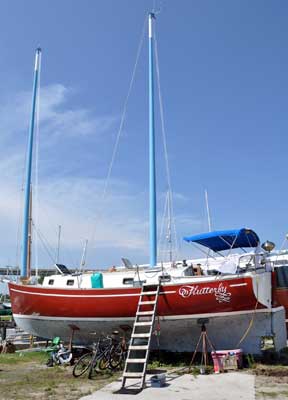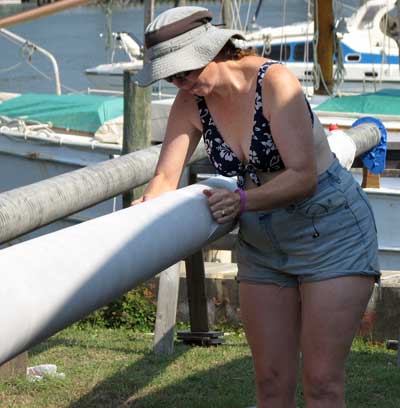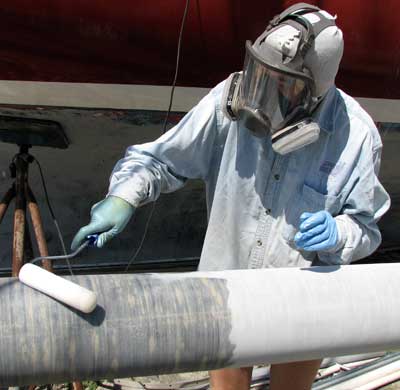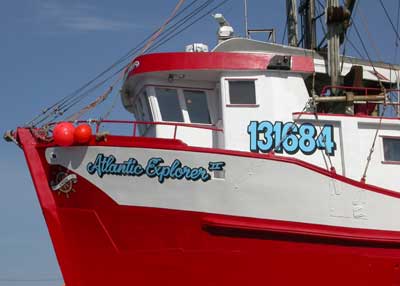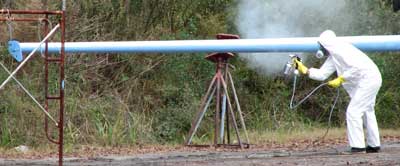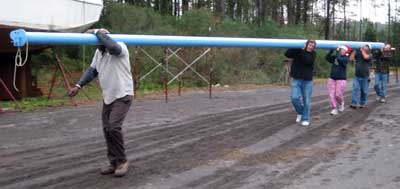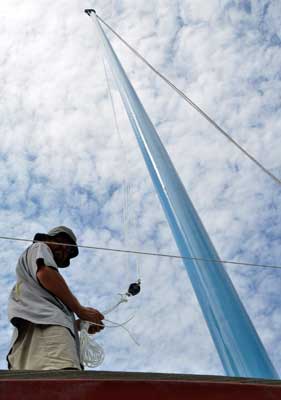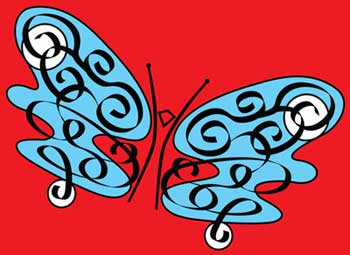“Help others, because magically, when you need help, it will be there for you.”
You may be one of them, those so-called “friends” who tease us about taking 2-1/2 years for a simple boat refit. That’s enough teasing. Because from another perspective, 2-1/2 years is sadly too short.
In 2007, when we bought Flutterby, we needed a marine survey. We lucked upon a wonderful surveyor — a Sir Veyor, to use Steve Roberts’ phrase — who turned into a friend. Jon Roop understood exactly what we were trying to accomplish. He was the reason we ended up in Beaufort, because he told us there was plenty of support available to do-it-yourself boaters there. Best of all, he said we could call him any time we had questions, as long as we owned the boat.
We tried to exercise restraint and only call when the question was really serious. But every time we did, he extended an invitation to dinner or a party at the beautiful house where he lived with his vivacious partner, Carol. This, despite my getting the Squid Wagon stuck in his driveway and having to call a tow truck to get it out (remember? I wrote about that).
As a former sailboat cruiser, Jon loved sharing the house, which he’d built himself. Every social gathering revolved around the giant kitchen island. Guests circulated around it, as if it was an indoor fire pit.
Jon would extend an impromptu dinner invitation to cruisers. “Bring your laundry, and take a shower,” he’d say. I was too shy to try the fancy jacuzzi in the guest bathroom, and I figured a shower was a shower. Then, at a gathering in January, I realized that was simply not true.
They’d thrown some sort of party a day or two before and had so much food left, they decided to invite more folks over to help finish it. There were about a dozen of us that evening, including some local friends and two British couples from the boatyard. There was some joking about The Shower, and one of Jon and Carol’s local friends realized from our dumb looks that Barry and I hadn’t seen it.
“Come on,” said Pam, dragging us back through the master bedroom. Elegantly tiled, it was the most magnificent shower I’ve ever seen in a private residence. It was the size of a small room, with showerheads on each wall and one coming out of the ceiling in the middle. There was room inside for about ten people showering, or two people dancing. I recalled many miserable, cold boatyard showers, and I decided not to be shy — I would bring my shower kit the next time I came over.
It was a pleasant, evening, with lots of stories and laughter. But it was a little low-key; Jon admitted, reluctantly, that he wasn’t feeling well.
News travels fast in a small town. It was only a couple of days after that dinner that I stopped at a local machine shop. “Did you hear about Jon?” He’d ended up in the hospital. “Not feeling well” turned out to be complications related to melanoma.
Everybody wanted to know what was going on. “Any news about Jon?” was the question around the boatyard and around town. Carol sent emails, forwarded by Pam, until finally they set up a Caring Bridge blog. For the next five months, Carol shared the good news and the bad news, and the frustration of dealing with the medical system. Whenever an email came in, “A new journal entry for Jonathan’s CaringBridge website was posted…”, I’d click on it immediately.
I can’t begin to express how much I valued Carol’s updates and the online community sending love, light, and prayers to Jon. When Carol described dealing with Nurse Ratchett and Doctor Numbskull, we all growled in unison. We cheered when Jon got into an experimental treatment program, but worried about him flying to Boston and Nashville for it. We celebrated when Jon proposed to Carol, and congratulations came from around the globe when they were married, right in his hospital room, about a week ago.
And we all cried this morning, when Carol wrote, “Today I deliver the news that everyone knew was coming but no one wanted to hear.” Jon passed away last night.
That’s why I wish this time had been longer than 2-1/2 years. I wanted to know him longer. Decades would have been nice. It would have been lovely to have him at Flutterby’s rechristening and relaunching party. And Barry and I only got to dance under that magical shower once.
Jon teased us a little about how long we were taking, but he also made the most poetic statement about our departure date. “One of these days, you’ll look up and see the geese migrating, and you’ll know then that it’s time to put the boat in the water and follow them.”
He was kind and generous and caring, and most of all, he had his priorities right. Jon’s cousin Steve wrote, “‘Help others because magically when you need help it will be there for you’ is the essential Jon Roop.”
That statement is also the essential sailboat cruiser. It should be the essential human. Jon Roop was a sailor who showed us how to be better humans. Now it’s up to us.
===
Jon’s photo is the top right one in Seven Precious Friends.

